Building decoration with artificial stone is becoming more and more popular with consumers. This method makes it possible to make the facades truly original, thereby showing the owner's inner world, his priorities and tastes.
In order for the result to completely satisfy you, and the finish does not collapse after a few years, you need to know the features of the finishing process and what the material is made of.
What are they made of
The technology is based on several stages of production:
- A base is made, which is most often made of cement with a filler... There are other options though.
- Material properties depend mainly on filler, and mainly on light weight... Fine-grained expanded clay helps to achieve this parameter. The material has a low density, which makes it possible to reduce the total weight of the relative natural stone. Also in production, expanded clay is replaced with pumice stone or ceramic chips.
- A very important component of the material - additives... Among them, there are strengthening components, plasticizers and reinforcing mixtures.
- Coloring the stone gives it the desired color and brightness... This is facilitated by coloring pigments, which must be of high quality, because the service life of the color and the possibility of its fading depend on them. Pigments can be added directly to the mixture or applied to the surface of the stone.
At the last stage, the artificial finishing stone for the facade is covered with water-repellent compounds.
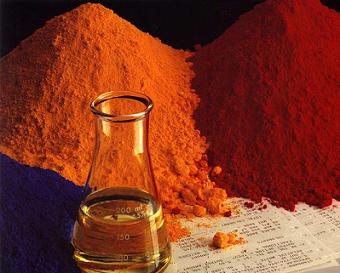
Laying technology
Surface preparation
The facade of the house can be finished with artificial stone, the walls of which are made of any materials, in particular from:
- concrete;
- bricks;
- foam blocks;
- profile panels;
- wood.
However, not all types of facing material require preparation of a perfectly flat surface. For example, when a product with a relief surface is used, imitating sandstone, where rough chips stand out, or raw stone.
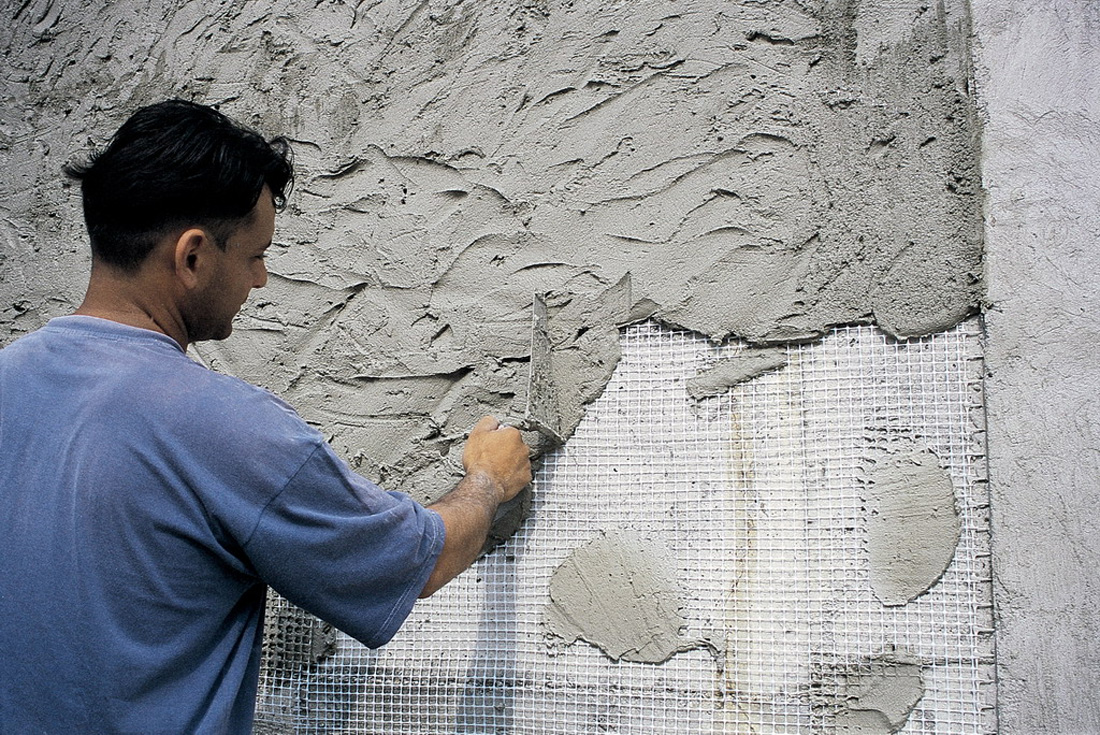
However, do not be lazy and check the wall for a plane so that there are no large differences. If you decide to use a product made for a river stone or brick, then take care of a perfectly flat surface.
Wall alignment
Facade decoration with artificial stone in most cases occurs on a flat wall surface. To do this, take a building rule and test it. If the clearance between it and the surface is no more than 3-5 mm, you can use the cladding without prior leveling.
In a different situation on brick and concrete walls it is necessary to plaster the pits or remove protruding parts.
For wood, more thorough preparation should be carried out:
- remove all protruding nails with your own hands;
- replace rotten boards and those touched by mold;
- fasten those that do not hold well;
- waterproof the places where the finishing will be done;
- install a reinforcing mesh on the wall.
Tip: on a flat surface, you can lay artificial stone directly on the mesh.
In another case, it must first be plastered.

The best way is to install a ventilated facade, otherwise, such walls can quickly rot.
- Create a crate on the surface.
- Attach chipboard or asbestos boards to it so that the surface is suitable for masonry.
- You can install insulation (polyurethane foam or mineral wool) between the posts of the crate.
Before installing the stone on the plastered surface, it must also be brought into compliance with the standards. To do this, thoroughly clean the walls from the old peeled plaster. Repair the surface by patching up the damaged areas, level them and rub them.
Choice of stone
- Check the artificial stone for finishing the facade from the packs for defects and put the substandard aside. Then they will not interfere with work and will not be caught at the wrong moment.
- Stir the selected items, as they may differ in color or shade from different batches. After such, they will be distributed naturally over the entire facade.
- Lay out the future drawing on a flat surface to determine the order of installation in advance.
- Cut off the protruding excess parts using a grinder ("grinder") with a disc over the stone.
- Use a metal brush to clean the side of the stone where you will be applying the adhesive.
Adhesive solutions
- They must consist of cement, sand, mineral and organic base, plasticizers and meet the following criteria:
- temperature compliance - the solution should be used for outdoor work, be resistant to temperature extremes and high humidity;
- the time for fixing the masonry should be from 30 minutes;
- working condition of the solution - up to 60 minutes;
- the best solutions are those made directly from dry mixes on site.
- The dry mixture should have the following characteristics:
- the consistency should allow the solution to be applied in a thin layer;
- the prepared mixture must be homogeneous and elastic;
- the density of the finished solution should be in accordance with the technical regulations - the stone should not slide over the glue mass.
Finishing technology
Below is suggested detailed instructions, which will help you understand the essence of the process:
- Dampen the wall surface with water or acrylic primer with a roller or wide brush about 20 minutes before laying the stone.
- Start from the top row to keep the bottom rows free of glue.

- Corner stones must be installed first, laying out the corners completely from top to bottom, the next ones around door and window openings. If you use even stones, keep the rows horizontally, if a different shape is optional. Then start laying ordinary masonry stones.
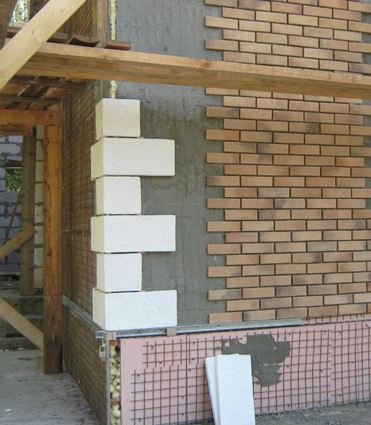
- Apply the solution to the stone and wall. Keep the face of the stone clean at all times. The adhesive layer is 5-10 mm.
- Apply the stone to the wall tightly, for which it should be moved to the sides. Make sure some glue comes out around the perimeter.
Masonry can be sutured and seamless, depending on the shape of the stone. In the first case, fill the distance between the stones with a special mortar for jointing. Usually, rounded or uneven stones are made with seams, and smooth ones without, but everything depends on you. When choosing a seamless method of installation, a solution protrudes from under the stones.

Joining is performed to seal the masonry:
- Lightly sand the seams between the stones.
- Use a dense polyethylene bag to fill the seams, fill it with mortar and cut off a corner of it less than the width of the seam.
- Press gently on the bag and carefully fill the seams. If the stone is stained, clean it immediately.
Advice: the facing of the facade with artificial stone should end at a level of 60-70 mm from the ground, so that it does not peel off the surface when it comes into contact with the ground or a frozen blind area during cold weather.
Output
Modern technologies have made it possible to create analogs of natural stone. Facade decoration with products on an artificial basis in many respects is not inferior to it, and their price and ease of maintenance surpass it.
Installation decorative stone does not differ in particular complexity, therefore it is often made independently. In the video presented in this article, you will find additional information on this topic.
Materials for finishing facades need to be thought out even at the design stage of the house. The appearance of the future building should ideally fit into the landscape design, be neat and beautiful. Facade decoration has several important functions:
- decorative;
- solves the issue of sound insulation;
- serves as home insulation.
All material must be durable, resistant to external irritants and perfectly tolerate climatic conditions. In this article, we will analyze in detail which facing products are best used for external work and reveal all the advantages and disadvantages of each.
Types of finishing materials
The modern construction market offers a lot of products for facade work. The most common products among buyers are:
- porcelain stoneware;
- decorative plaster;
- tiles or clinker bricks;
- siding;
- sandwich panel;
- natural or artificial stone;
- front cassettes.
All presented finishing materials for the facades of private houses have their own advantages and disadvantages, and also differ in pricing policy. Therefore, for the correct choice of a product, it is necessary to calculate their cost and take into account all the advantages. Thanks to finishing facade materials, specialists solve several problems, such as:
- uneven construction;
- possible geometric errors;
- wear and dilapidation of the facade of the building;
- additional insulation;
- decorative improvement and improvement in appearance.
Complete characteristics of facade products
Porcelain stoneware

Porcelain stoneware is one of the best solutions for cladding the facade of a building. The assortment of the product is rich in color palette and shapes, although it will not work to apply a picture on it. The iridescent look of porcelain stoneware looks especially attractive. Also, manufacturers produce porcelain stoneware in the form of wood or stone, this material looks natural and natural. The main properties of this material:
- has high strength and long service life;
- resistant to mechanical damage;
- has high moisture resistance, the structure of the product does not absorb water, due to this, cracks do not form on the surface and frost is perfectly tolerated;
- resistant to any temperature regime, it is also worth noting that porcelain stoneware does not burn;
- has a stable color, does not fade in the sun;
Complex installation is perhaps the only drawback. For the installation of porcelain stoneware use metal carcass or glue. It is better not to use a cement mortar, because the lining may fall off.
Porcelain stoneware products are:
- matte;
- mosaic;
- polished;
- glazed;
- structured;
- polished;
- semi-polished.
Decorative plaster
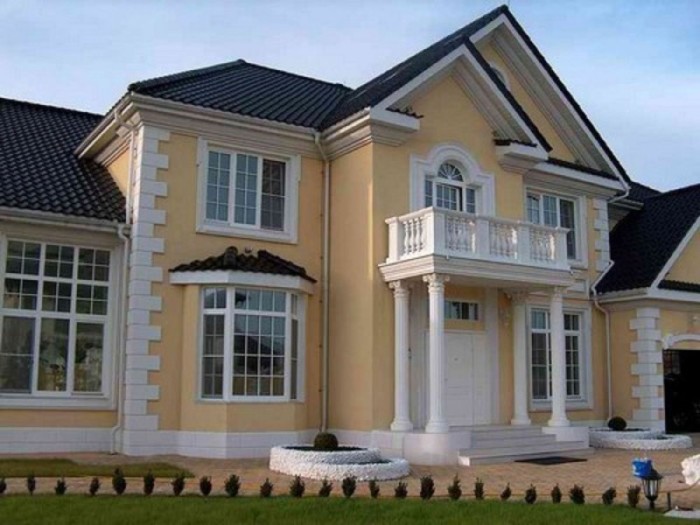
Application decorative plaster for the facade of a house is considered one of the first methods of cladding a structure. Over the past decades, plaster has become strong and resistant. Thanks to the large selection, you can find a mixture that is smooth or with different patterns. Main characteristics:
- Aesthetic appearance. Thanks to the large number of colors and textures, you can give a beautiful look to your home
- Increased water resistance. Plaster is able to protect the building from moisture and dampness.
- Frost resistance. It tolerates high temperatures perfectly, does not crack or burst.
- Easy to apply. The mixture is easily applied to the facade of the building, it does not require the use of special equipment.
Types of decorative plasters:
Mineral mixture is the most common, the main advantages are considered to be low cost and a large selection of colors. Differs in high biological resistance, which excludes the formation of harmful microorganisms. The scope is wide enough, due to the fact that the mixture does not burn, it is also used for decoration in flammable buildings. Of the disadvantages, it is worth noting poor elasticity; cracks may form when the foundation shrinks.
Acrylic mix, unlike mineral mix, has good elasticity and does not crack when the house shrinks. Such plaster is resistant to frost and moisture. The material does not burn, but it is not recommended to combine it with mineral wool insulation. Its disadvantage is that the surface becomes dirty quickly.
Silicate mixture, according to professionals, is considered the most durable. This plaster can last about 30 years without losing its appearance. The main advantage is that even if the facade is smeared, then under the influence of rain all the dirt is quickly washed off. It also does not allow moisture to pass through and tolerates frost well.
Silicone mixture the most modern and ideal type of plaster. This bulk has no drawbacks, except for one, high cost. It gets along well with all types of facade structures and can serve long time, self-cleaning with wind and precipitation.
Clinker brick
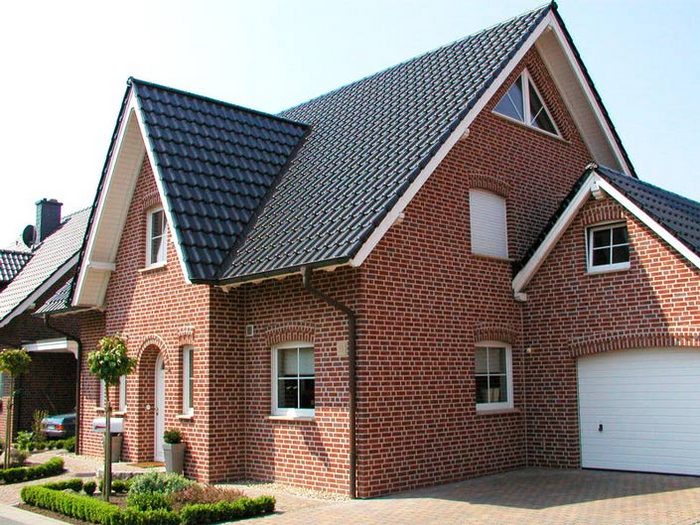
Clinker bricks are often used as finishing materials for. In appearance, it resembles an ordinary brick, and there are more than 100 types of items. Produce it from natural materialsby adding clay and various dyes. Brick is divided into 3 main types:
- front;
- sidewalk;
- the tile is facing.
Clinker brick is durable, does not absorb moisture, and has high chemical resistance. A façade finished with facing tiles or bricks tolerates high and low temperatures well. The only drawback is the high cost and complexity of installation.
Siding
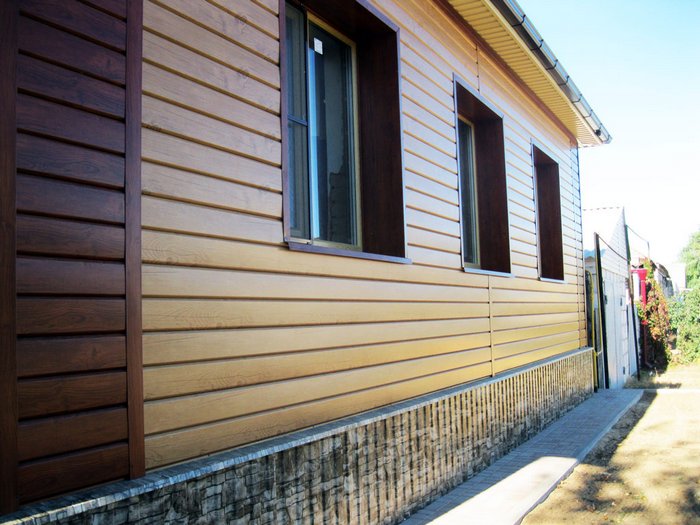
Decorative siding is the most successful home decoration. Sheathing a house with siding with your own hands is an easy task, this material is not difficult to install and does not require the use of heavy equipment. Siding perfectly protects the house from external irritants and insulates it. There are several varieties of this product:
- vinyl plates: not expensive material, not resistant to mechanical damage;
- wooden slabs:made of wood, keeps heat well, has a beautiful appearance, short service life and constant care are considered a disadvantage;
- metal plates: they are made of steel, strong enough, but there is a drawback, if the panel is damaged, a corrosive process may form;
- cement slabs:heavy siding, which makes the entire structure heavier, therefore, when attaching cement siding, you need to strengthen the foundation;
- base plates:it is a thick product designed for a tall structure.
Sandwich panels
This material consists of two stitched layers, between which insulation is laid. Most often it is used for cladding new buildings and renovating old ones, to give a beautiful appearance. Sandwich panels are moisture resistant, fireproof and tolerate any temperature well. Another pleasant feature is that when one panel is deformed, it can be replaced without dismantling the adjacent ones. The disadvantage of such panels is their high cost.
Natural or artificial stone

The facade of a stone house always looks rich and beautiful. The product is quite expensive, but justified. By its characteristics, the stone is durable, reliable and resistant to any irritation and damage. Facing the facade of a house with a stone will help solve any of your design ideas.
The photo shows the facades of houses sheathed with artificial stone
Facade cassettes
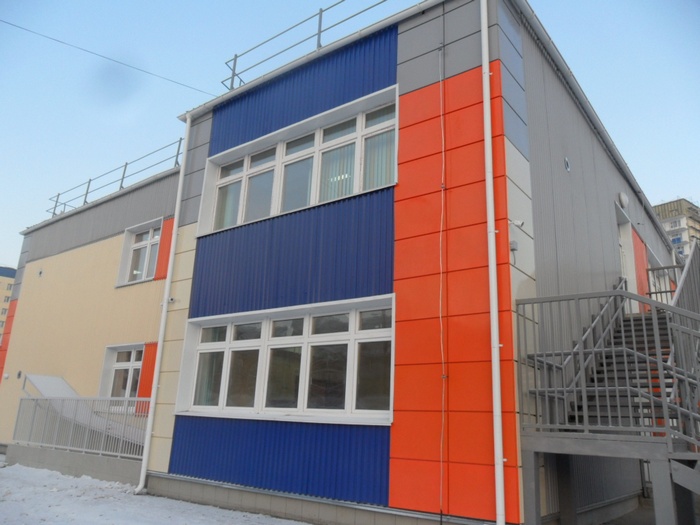
House cladding with facade cassettes is ideal for installing a ventilated facade. Such cassettes are fastened with self-tapping screws, using hidden or open methods. Has a large selection of colors and sizes. The product is reliable, fireproof, resistant to moisture, frost and mechanical damage. Facade cassettes are ideal for cladding a new building or putting in order an old house... Of the disadvantages, only the high cost should be noted.
As you can see, there is a large selection of products for cladding the front of the house. Each material has its own advantages and disadvantages. If you feel in doubt when choosing finishing material, view the photos already finished projectsperhaps they will help you visually represent your home and make right choice... In any case, do not skimp on material, because not only the appearance of the structure depends on it, but also its service life.
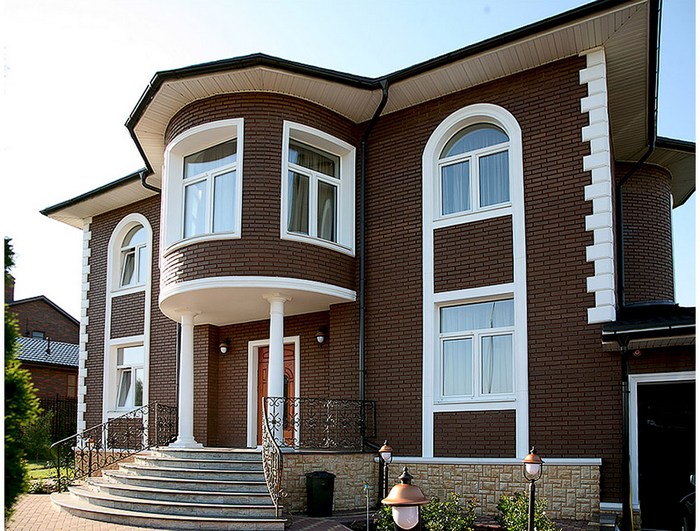
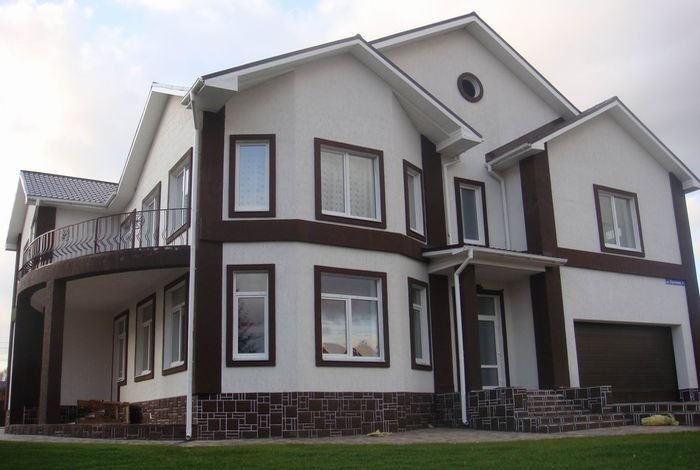
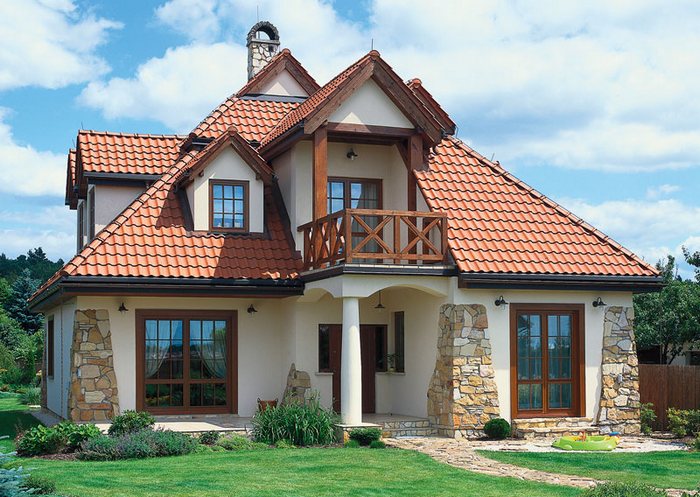
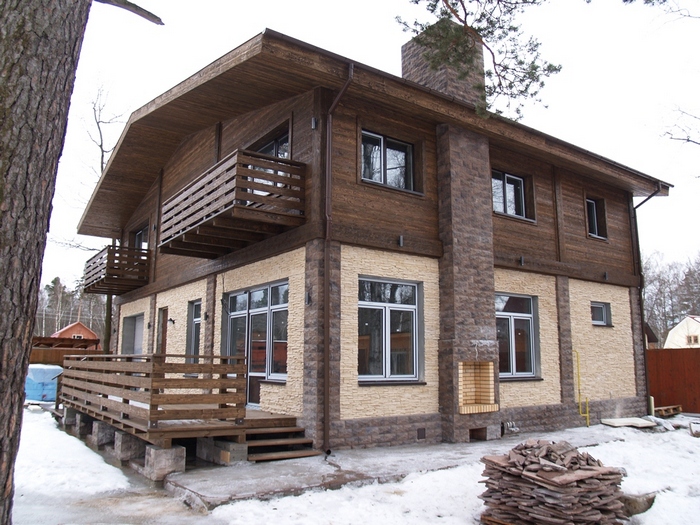
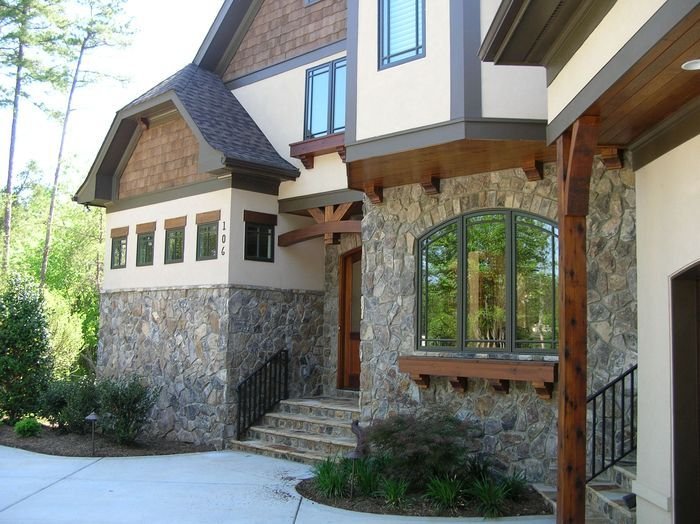
Facade decoration with panels
from 680 rub. / m 2
Facade finishing with plaster
from 350 rubles / m 2
Facade decoration with artificial stone
from 1250 rub. / m 2
We offer finishing of facades of houses with artificial stone at a cost of work from 1250 rubles / m2 (10.2014). We have professional craftsmen on our staff, and hundreds of completed projects under our belt. We give a 3-year guarantee for the quality of the artificial stone facade!
Facing the facades of houses with artificial stone
Finishing process
- Masters carry out the preparation of the bases in accordance with SNiP 3.03.01. Loose surfaces are removed. If necessary, carry out partial repairs or complete leveling of the walls. Prepared bases are primed.
- After delivering the materials, the master lays out the stones on a flat surface in order to draw up the future drawing of the facade cladding.
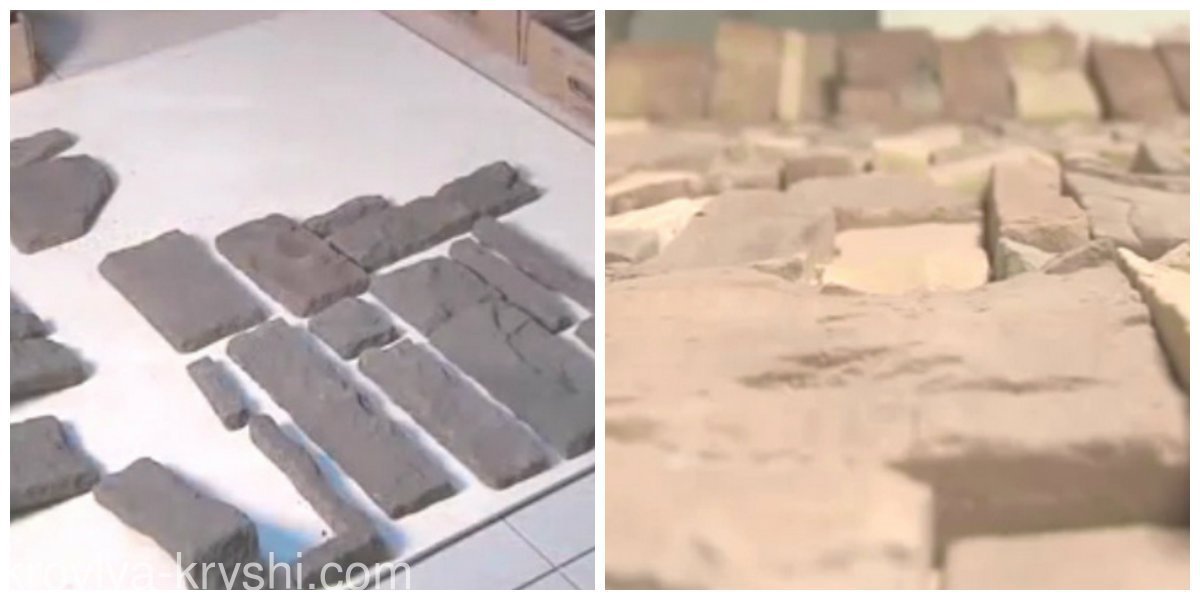 Layout execution
Layout execution
- Our craftsmen analyze combinations of different stones. Experts select such solutions, in which there are no accumulations of small or large stones in one part of the picture. This work requires a special quality. The aesthetic appearance of your stone facade depends on how successfully the master performs the layout.
- When performing work in low humidity or high temperature the artificial stone is moistened.
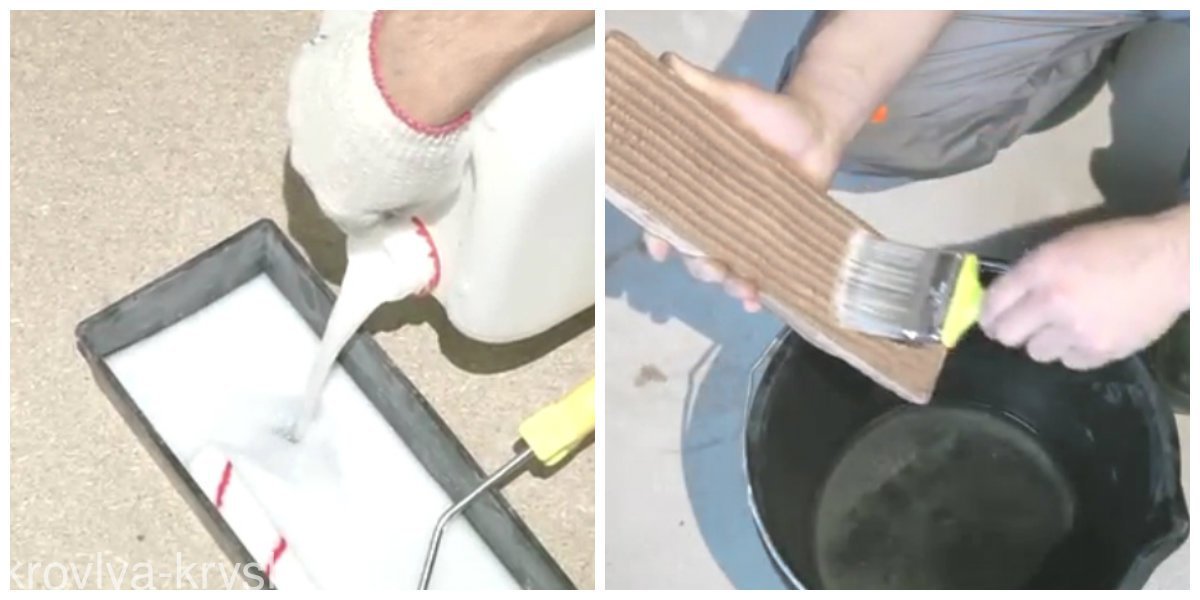 Preparing for priming and wetting the stone before laying
Preparing for priming and wetting the stone before laying
- Craftsmen prepare a special glue mixture and transfer the layout pattern to the facade. We select the right glue depending on the weight of the stones.
- Cladding starts from the corner of the building. For this, craftsmen use the short and long sides of the corner pieces for each side of the facade.
- The glue is applied to the wall and stone.
- For stronger adhesion, the stones are lightly tapped with a mallet. During the masonry process, craftsmen control the thickness of the joints between the cladding elements.
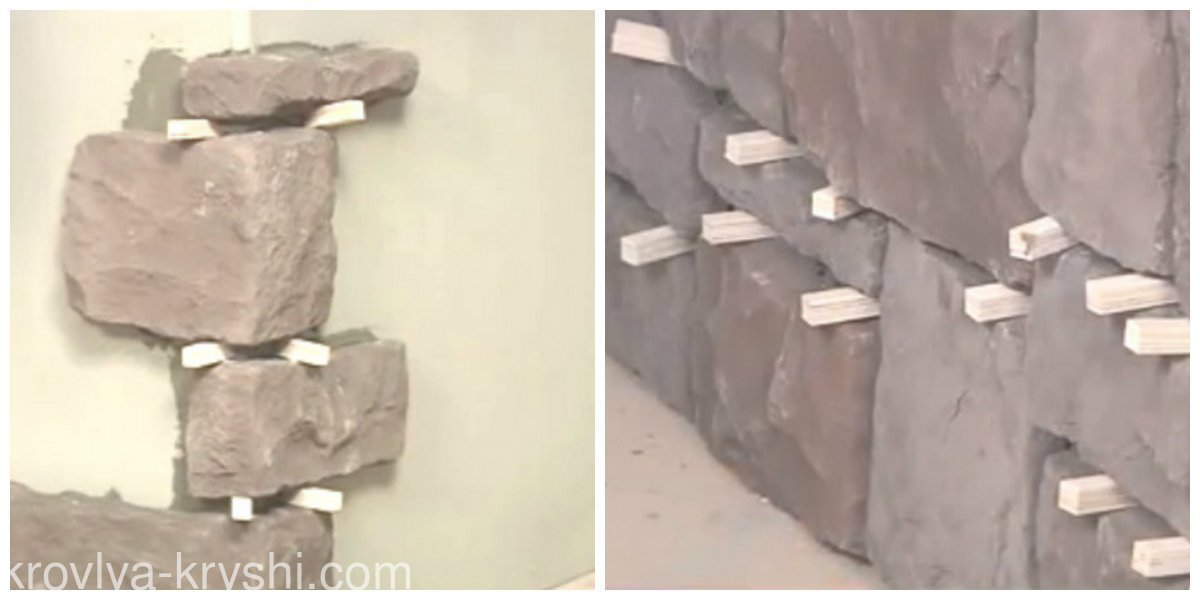 Starting from a corner and performing work
Starting from a corner and performing work
- The masters begin to join the joints after drying. adhesive composition... As a rule, this happens at least 3 days later. The seams are filled with a special grouting solution that imitates the masonry mixture and protects the finish from moisture. A syringe gun is used for this operation. After the solution has dried (at least 30 minutes), the masters smooth it with a curly spatula.
 Filling and grouting
Filling and grouting
- After the joints are completely dry, remove the remnants of the grout with a brush.
- To protect the masonry from moisture, it is sprayed with a special solution. Perform this operation after the cladding is completely dry.
- Artificial stone finishing is carried out at a temperature from + 5 ° C to + 25 ° C.
- For cladding wooden bases, a waterproofing layer is needed, along which plastering with reinforcement is performed.
- When applying a thick layer of glue, the artificial stone may slip from the facade surface.
- Check the date of manufacture of artificial stones and the batch of each package. This will ensure that the color of your facade is consistent.
- Buy a stone with a small margin. The smaller the cladding area, the more stock is needed. Roughly the quantity of goods is increased by 3 ... 15%.
Artificial stone finishing requires high skills. Our masters offer best options for facade design that will decorate modern house or a cottage. Call, find out the details and order quality with a turnkey guarantee!



